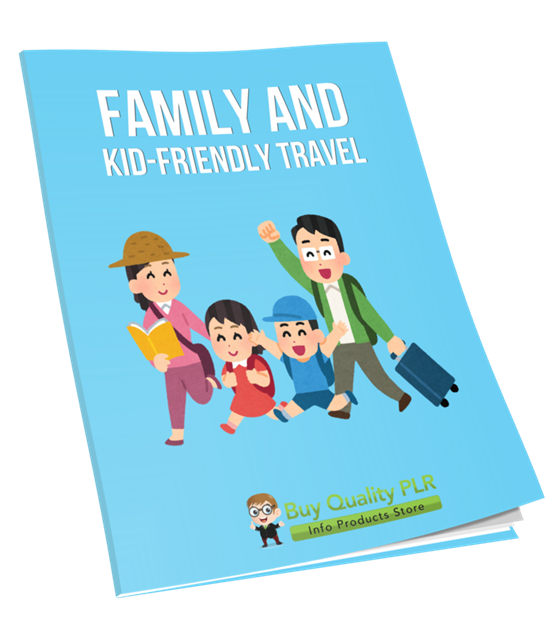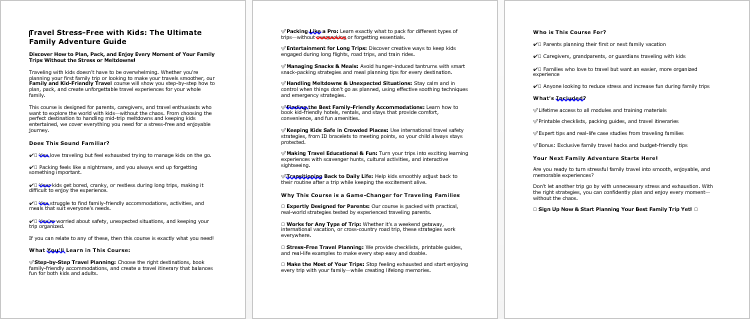
Family and Kid-Friendly Travel PLR Course 19k Words
in Family PLR , Kids PLR , Kids PLR Ebooks , PLR eBooks , PLR eCourses , PLR List Building Reports , Premium PLR , Premium PLR eBooks , Premium PLR Reports , Premium White Label Brandable PLR Coaching Courses , Private Label Rights Products , Travel PLR , Travel PLR eBooksChoose Your Desired Option(s)
has been added to your cart!
have been added to your cart!
#familytraveltips #kidfriendlytravel #travelwithkids #plrcontent #familyvacationideas #travelcourse #plrcourse #traveleducation #travelplanning #familyadventures
Family and Kid-Friendly Travel PLR Course: Your Ultimate Guide to Stress-Free, Fun-Filled Family Vacations
Welcome to the Family and Kid-Friendly Travel PLR Course, your go-to resource for making family vacations easier, more enjoyable, and full of wonderful memories. This course is perfect for parents, caregivers, and travel enthusiasts looking to create stress-free, fun-filled trips that everyone in the family can enjoy.
Whether you’re planning your first family trip or looking for ways to improve your travel planning skills, this step-by-step guide will ensure your next family vacation is organized, enjoyable, and memorable.
Presenting…
Family and Kid-Friendly Travel PLR Course 19k Words
Course Overview
Family travel is an adventure, but planning it can be overwhelming. The logistics of juggling the needs of parents, kids, and sometimes even grandparents can turn what should be a fun experience into a stressful situation. This course will teach you how to avoid common travel pitfalls and make your family trips stress-free and enjoyable for everyone.
In this Family and Kid-Friendly Travel PLR Course, you’ll learn how to plan your next vacation with confidence, from budgeting and packing to selecting the best kid-friendly destinations and managing family dynamics on the go. We’ll provide practical tips and strategies that make traveling with kids both fun and stress-free.
By the end of the course, you’ll have everything you need to create an unforgettable family vacation that accommodates everyone’s needs.
Course Modules:
Module 1: Planning the Perfect Family Trip
Planning is key to a successful family vacation. This module covers the essentials of choosing the right destination, creating a family-friendly itinerary, and managing your budget effectively.
- Step 1: Choosing the Right Destination
Learn how to select family-friendly locations that offer activities for all ages, from theme parks to beach resorts and nature retreats. - Step 2: Budgeting for Your Trip
Set a realistic budget and discover how to factor in hidden costs. Learn how to look for family discounts and bundle deals for maximum savings. - Step 3: Creating a Family-Friendly Itinerary
Find the balance between sightseeing and relaxation. Plan activities that keep the kids engaged while allowing parents time to unwind. - Step 4: Packing Like a Pro
Get practical packing tips for family travel. Learn what essentials to bring to ensure a smooth trip for everyone.
Module 2: Traveling with Kids – Stress-Free Strategies
Traveling with kids requires preparation and flexibility. This module provides strategies to keep your kids entertained, fed, and comfortable on long trips.
- Step 1: Preparing for the Journey
Get your kids excited for the trip. Talk about the journey ahead, involve them in planning, and set travel expectations. - Step 2: Entertainment for Long Trips
Keep kids engaged during long flights or car rides with travel games, audiobooks, and creative activities like drawing or storytelling. - Step 3: Managing Snacks & Meals on the Go
Learn how to pack healthy, travel-friendly snacks and research kid-friendly food options at your destination. - Step 4: Handling Meltdowns & Unexpected Situations
Stay calm in stressful situations and learn ways to soothe your kids when things don’t go as planned.
Module 3: Choosing the Best Family Accommodations
Accommodation can make or break a family trip. This module will guide you in selecting the best places to stay, whether it’s a hotel or vacation rental.
- Step 1: Finding Kid-Friendly Hotels or Rentals
Discover what to look for in family-friendly accommodations, such as family suites, kitchenettes, and on-site amenities like pools or playgrounds. - Step 2: Safety & Convenience Considerations
Learn how to choose accommodations in safe, accessible areas close to family attractions and essential services. - Step 3: Booking Smart – What to Look For
Get tips on checking reviews, confirming availability of baby gear, and understanding cancellation policies. - Step 4: Keeping Kids Comfortable Away from Home
Tips on bringing familiar items, like a favorite blanket or bedtime story, to help kids adjust to a new environment.
Module 4: Exploring New Places with Kids
Make your sightseeing experience enjoyable for the whole family. This module provides practical tips for visiting kid-friendly attractions and balancing activities for everyone.
- Step 1: Kid-Friendly Sightseeing Tips
Learn how to choose interactive and hands-on attractions such as zoos, museums with play areas, and nature walks. - Step 2: Keeping Kids Safe in Crowded Places
Learn how to keep your kids safe in busy tourist spots by using ID bracelets, establishing meeting points, and preparing for separation. - Step 3: Balancing Adult & Kid Activities
Plan activities that satisfy both kids and adults. Take turns picking attractions to ensure everyone has fun. - Step 4: Making Travel Educational & Fun
Turn your trips into learning experiences with creative activities like scavenger hunts, cultural lessons, and storytelling.
Module 5: Returning Home & Making Memories Last
The journey doesn’t end when you return home. This final module will help you wind down after your trip and create lasting memories.
- Step 1: Managing Post-Trip Unpacking & Organization
Get organized after your trip by unpacking and storing travel essentials for future use. - Step 2: Helping Kids Transition Back to Routine
Learn strategies for easing your kids back into their routine with restful days, familiar meals, and gentle reminders of home life. - Step 3: Creating Lasting Memories
Use photos, journals, or scrapbooks to document the special moments from your trip. - Step 4: Planning the Next Adventure!
Discuss what everyone loved most and start planning your next family trip.
Conclusion: Stress-Free, Fun-Filled Family Travel
By the end of this course, you will have all the tools you need to plan and enjoy a family vacation that caters to everyone’s needs. With these strategies in hand, you’ll be able to handle every aspect of your trip with confidence and ease, from budgeting to choosing the best kid-friendly activities.
Remember, family travel is about creating memories, and with the Family and Kid-Friendly Travel PLR Course, you’re ready to make every trip special!
Bonus Materials Included:
In addition to the course, you’ll receive these helpful bonus materials to make your travel planning even easier:
- Family and Kid-Friendly Travel Checklist – 485 words
- Family and Kid-Friendly Travel FAQs – 910 words
- Family and Kid-Friendly Travel Salespage – 645 words
These bonuses will help streamline your travel preparation, offering handy tools to stay organized and answer common travel questions.
How to Use and Profit from the Course
The Family and Kid-Friendly Travel PLR Course comes with full Private Label Rights (PLR), giving you the flexibility to edit, rebrand, and resell this content as your own. Here are a few ways you can use the course:
- Resell the Course: Market and sell the course directly to families and parents looking to travel with kids.
- Create a Membership Site: Offer ongoing travel tips and updates as part of a subscription-based membership site.
- Bundle with Other Travel Content: Combine this course with other travel-related content for a more comprehensive offering.
- Turn it Into Interactive Content: Convert the course into video tutorials, live webinars, or interactive workshops.
- Create Physical Products: Print the content as a physical guide or workbook for parents to use during their travels.
- Use It for Lead Generation: Offer parts of the course as free downloadable PDFs or blog posts to build your email list.
License Terms:
What You Can Do:
- Sell the content as-is or with minor edits.
- Break up the content into smaller portions and sell individual reports.
- Create a membership site offering the course and related materials as a subscription.
- Turn the course into a multi-week “eclass” or paid training program.
- Convert the content into physical products like books or guides.
- Use the content for creating video, audio, or interactive learning experiences.
- Excerpt parts of the course for blog posts or lead magnets.
What You Can’t Do:
- Pass the PLR rights to your customers.
- Offer 100% affiliate commissions for your products.
- Give the entire course away for free in its original format.
- Add the content to existing customer orders without an additional charge.
Start Your Stress-Free, Fun-Filled Family Adventure Today!
The Family and Kid-Friendly Travel PLR Course is your ultimate tool for creating the best family vacations. Plan, execute, and enjoy your trips with ease and confidence. Get started now and make your family travels a memorable experience for everyone!
has been added to your cart!
have been added to your cart!
Here A Sample of Family and Kid-Friendly Travel PLR Course
A Step-by-Step Guide to Stress-Free, Fun-Filled Trips!
Module 1: Planning the Perfect Family Trip
Step 1: Choosing the Right Destination
When planning a family trip, selecting the right destination is one of the most important steps. A well-chosen location can make the difference between a stress-free, enjoyable experience and a trip filled with logistical challenges. The key is to find a place that offers activities for all ages, ensuring that both children and adults can have a memorable time.
Consider Your Family’s Needs and Interests
Every family is unique, so start by identifying what kind of experience you want. Ask yourself the following questions:
- Are you looking for relaxation, adventure, or cultural exploration?
- Do you prefer warm climates, cool mountain air, or urban settings?
- What are your children’s ages and interests? Younger kids may enjoy playgrounds and interactive museums, while older children might prefer outdoor adventures or amusement parks.
- Are there any accessibility needs, dietary preferences, or medical considerations to take into account?
By answering these questions, you can narrow down the best type of destination for your family.
Research Family-Friendly Destinations
Some destinations are better suited for families than others. Consider places known for being family-friendly, with accommodations, attractions, and services designed for children and parents.
Here are some top family-friendly travel categories to explore:
- Theme Parks and Entertainment Resorts
- Perfect for families with children of all ages, theme parks offer rides, shows, and interactive experiences.
- Well-known destinations include Disneyland (United States, France, Japan, Hong Kong, China), Universal Studios (United States, Singapore, Japan), and LEGOLAND parks around the world.
- Many resorts near theme parks offer family packages, character dining experiences, and child-friendly services.
- Beach Resorts and Island Getaways
- If your family loves sun and sand, consider destinations with family-friendly beaches.
- Look for shallow, calm waters and resorts offering kid-friendly amenities like splash pools, water sports, and children’s activity programs.
- Great options include the Maldives, Bali (Indonesia), Gold Coast (Australia), Phuket (Thailand), and the Caribbean.
- Nature Retreats and Adventure Trips
- National parks and nature reserves provide incredible opportunities for outdoor exploration, hiking, and wildlife spotting.
- Destinations like Costa Rica, Canada’s Banff National Park, Switzerland’s Alps, and South Africa’s safari parks offer breathtaking landscapes and safe, family-oriented activities.
- Look for eco-lodges, guided family hikes, and interactive learning experiences that make nature fun for kids.
- Cultural and Educational Destinations
- If your family enjoys history and culture, explore cities known for their museums, historical sites, and interactive exhibits.
- Consider Rome (Italy) for ancient history, London (UK) for museums and royal landmarks, Kyoto (Japan) for traditional temples and tea ceremonies, or Washington D.C. (USA) for interactive museums and monuments.
- Many major cities offer family-friendly city passes that include entry to top attractions at discounted rates.
Check Safety and Accessibility
When traveling with children, safety and accessibility should be top priorities. Here’s what to check before finalizing your destination:
- Health and Safety Regulations: Research vaccination requirements, emergency medical facilities, and the overall safety of the country.
- Transportation Ease: Choose destinations with reliable public transportation, walkable areas, or family-friendly car rental options.
- Kid-Friendly Accommodations: Look for hotels with cribs, babysitting services, and family-friendly dining options.
Look for Family Deals and Discounts
Many destinations offer family passes, free admission for young children, and special discounts on accommodations, attractions, and transportation. When researching, check:
- Family travel packages from airlines and hotels.
- Discounted multi-attraction passes in major cities.
- Seasonal promotions that offer better rates for families.
Make a Final Decision and Start Planning
Once you’ve narrowed down your options, involve your children in the final decision. Show them pictures, videos, and activity options to build excitement. After choosing your destination, start planning your itinerary, accommodations, and travel logistics to ensure a smooth and enjoyable trip for the whole family.
Step 2: Budgeting for Your Trip
Budgeting is a crucial step in planning a successful family vacation. A well-planned budget ensures that you stay within your financial limits while still enjoying a comfortable and memorable trip. When traveling with children, unexpected expenses can arise, so it is important to factor in all potential costs, including hidden fees and optional expenses. By setting a realistic budget, looking for cost-saving opportunities, and prioritizing your spending, you can create an enjoyable experience without financial stress.
Determine Your Total Travel Budget
Before booking anything, decide how much you are willing to spend on the entire trip. Consider your total household income, savings, and any additional funds you may have set aside for travel. A good practice is to establish a maximum spending limit and break it down into different categories such as transportation, accommodation, food, entertainment, and miscellaneous expenses.
Start by listing out the major expense categories:
- Flights or other transportation costs (train tickets, fuel, car rentals, or bus fares)
- Accommodation expenses (hotels, vacation rentals, or resort stays)
- Daily food budget (meals at restaurants, grocery shopping, snacks, and drinks)
- Activities and entertainment (theme park tickets, tours, entrance fees, and recreational activities)
- Shopping and souvenirs (gifts, clothing, and special purchases)
- Travel insurance and medical expenses (coverage for emergencies and unexpected health issues)
- Miscellaneous costs (visa fees, baggage fees, mobile data plans, and tipping)
By categorizing your expenses, you can gain a clear understanding of where your money will go and identify areas where you may need to cut costs or reallocate funds.
Factor in Hidden Costs
Many travelers underestimate the hidden costs that can arise during a trip. When traveling as a family, these costs can quickly add up. Consider the following potential hidden expenses:
- Baggage fees: Airlines often charge extra for checked luggage, oversized bags, or overweight suitcases. Research baggage policies before booking your flight.
- Transportation at your destination: Taxis, ride-sharing services, public transport, or rental car fuel costs can vary widely depending on the city and country.
- Resort fees and service charges: Some hotels charge additional resort fees, cleaning fees, or city taxes that may not be included in the advertised room rate.
- Food and drink markups: Restaurants in tourist-heavy areas tend to have higher prices. Factor in grocery shopping for snacks and meals where possible.
- Currency exchange fees: If traveling internationally, research the best ways to exchange money without incurring high transaction fees.
- Childcare or babysitting services: Some resorts or hotels offer childcare services, but these may come at an additional cost.
- Emergency expenses: Always have a small emergency fund in case of medical needs, lost items, or travel disruptions.
By anticipating these expenses in advance, you can avoid surprises and ensure that your trip stays within budget.
Look for Family Discounts and Package Deals
Families can take advantage of many discounts and package deals that help reduce costs. Here are some strategies to find and maximize savings:
- Flight and transportation deals: Airlines often provide discounts for children under a certain age, while some train and bus companies offer family fares. Booking in advance and traveling during off-peak seasons can also lower costs.
- Accommodation promotions: Many hotels and resorts offer family-friendly packages that include free meals for children, complimentary activities, or discounted rates for longer stays. Look for properties with kitchenettes to save on dining expenses.
- Attraction and entertainment passes: Cities with major attractions often sell multi-attraction passes that provide access to several sites at a discounted rate. Look for family bundles at amusement parks, museums, and cultural sites.
- Restaurant and dining savings: Some restaurants offer free meals for kids or provide discounts during specific hours. Research local dining deals or use food delivery apps that offer discounts.
- Loyalty programs and cashback options: If you frequently travel, signing up for airline, hotel, or credit card reward programs can help you accumulate points for future savings. Some travel credit cards offer cashback on travel-related expenses.
Always compare package deals and check for special promotions before finalizing any bookings. Sometimes bundling airfare, hotel, and rental car reservations can lead to significant savings.
Track Your Spending and Adjust as Needed
Once you have set a budget, it is important to track your expenses throughout the trip. Use budgeting apps, spreadsheets, or a simple notebook to record daily spending. Regularly reviewing your budget will help you stay on track and make adjustments if necessary.
If you find yourself overspending in one category, consider cutting back in another area. For example, if an unexpected expense arises, you might adjust by choosing a more affordable restaurant for dinner or opting for free activities instead of paid excursions.
A flexible but well-planned budget ensures that you enjoy your trip without financial stress. By carefully considering all potential costs, taking advantage of available discounts, and tracking your spending, you can create an unforgettable travel experience while staying within your means.
Step 3: Creating a Family-Friendly Itinerary
Planning a well-balanced itinerary is essential for a successful family vacation. When traveling with children, the key is to find the right mix between sightseeing, engaging activities, and downtime. A well-structured itinerary should be flexible enough to accommodate unexpected changes while ensuring that everyone in the family—both kids and adults—gets to enjoy the trip.
A family-friendly itinerary should consider the interests, energy levels, and needs of all family members. Overloading the day with too many activities can lead to exhaustion and frustration, while too much free time may result in boredom. The goal is to create a plan that keeps children entertained, allows parents to relax, and makes the most of the travel experience.
Plan Each Day with a Balanced Schedule
A well-balanced itinerary consists of structured activities, relaxation breaks, and unplanned exploration. To create a family-friendly schedule, follow these key principles:
- Start the day with a main activity: Plan one major attraction or sightseeing experience in the morning when children are well-rested and more cooperative. This could be a visit to a theme park, zoo, museum, or guided tour.
- Include flexible midday breaks: Kids often get tired after a few hours of sightseeing, so schedule a lunch break with downtime. Choose restaurants with play areas, family-friendly menus, or picnic spots where children can move around freely.
- Alternate high-energy and low-energy activities: If your morning activity involves a lot of walking, make sure the afternoon includes something more relaxed, such as a boat ride, a cultural performance, or time at a playground.
- Leave room for spontaneous exploration: Avoid over-scheduling the day. Leave some free time for unexpected discoveries, whether it’s a street performance, a charming café, or a scenic park.
- Wind down in the evening: Plan a calm activity, such as a sunset stroll, storytelling at the hotel, or a family movie night, to help children settle before bedtime.
By structuring the day in this way, you can keep energy levels balanced and reduce the risk of crankiness and fatigue.
Choose Activities That Engage Kids and Adults
The best family vacations are those where both children and parents find activities they enjoy. Look for destinations that offer interactive and educational experiences that capture children’s curiosity while still being engaging for adults. Some options include:
- Outdoor adventures: National parks, beaches, and nature reserves offer hiking, wildlife spotting, and water activities that keep kids active and provide a peaceful environment for parents.
- Cultural experiences: Museums, historical sites, and cultural performances often have special programs for kids, such as scavenger hunts, interactive exhibits, and hands-on workshops.
- Amusement parks and entertainment centers: Theme parks, water parks, and interactive play zones are perfect for families, offering a mix of thrill rides and relaxing spaces for parents.
- Creative activities: Cooking classes, craft workshops, or music lessons allow kids to engage in local culture while giving parents a chance to enjoy the experience together.
- Free play areas: Parks, playgrounds, and open spaces provide children with the chance to burn off energy, while parents can unwind and watch from a comfortable spot.
By selecting activities that are enjoyable for both children and adults, you ensure that the entire family has a fulfilling and memorable experience.
Allow for Rest and Downtime
Traveling with kids requires more breaks and downtime than an adult-only trip. If children become overtired or overstimulated, they may become cranky and difficult to manage. To keep the trip enjoyable, make rest a priority:
- Schedule daily rest periods: Set aside time for naps or quiet moments, especially for younger children.
- Choose accommodations with relaxation options: Family-friendly hotels with pools, play areas, or on-site activities can provide a comfortable place to unwind.
- Be mindful of travel time: Avoid scheduling back-to-back activities that require long commutes. Plan sightseeing in clusters to minimize travel fatigue.
- Incorporate screen time or personal entertainment: While limiting screen time is important, allowing children to watch a movie, play a game, or listen to music during downtime can help them recharge.
Downtime ensures that kids remain in a good mood and parents get the chance to relax as well. A well-rested family is more likely to enjoy the travel experience without unnecessary stress.
Adapt the Itinerary Based on Family Needs
Flexibility is key when traveling with children. While having a plan is essential, it’s equally important to be ready to adjust it based on how the day unfolds. Unexpected situations such as bad weather, sudden fatigue, or a change in interest may require shifting plans.
- Prepare backup activities: Have a list of alternative activities in case something doesn’t go as planned. If an outdoor excursion is canceled due to rain, a nearby indoor attraction can be a good replacement.
- Be open to skipping activities: If children are tired or overwhelmed, it’s okay to drop an activity from the schedule. Forcing them to continue may lead to frustration for everyone.
- Listen to your kids’ preferences: While adults often plan the itinerary, allowing children to have input on daily activities can make them feel involved and excited.
- Have essentials on hand: Carry snacks, water, and extra clothes to handle unexpected situations smoothly.
A well-thought-out yet flexible itinerary ensures that everyone in the family has an enjoyable, stress-free trip. By balancing sightseeing with rest time and including engaging activities for kids, you can create a travel experience that leaves lasting memories for the entire family.
Step 4: Packing Like a Pro
Packing efficiently is one of the most important aspects of stress-free family travel. A well-packed bag ensures that you have everything you need while avoiding excess baggage that can slow you down. Whether you’re traveling by plane, train, or car, packing light but smart will make the journey smoother for both parents and children.
The key to successful packing is to focus on essentials, minimize unnecessary items, and ensure easy access to important belongings during travel. Family-friendly travel requires extra planning, as you need to prepare for various situations, including entertainment for kids, unexpected weather changes, and minor medical emergencies.
Choose the Right Luggage and Packing Strategy
Selecting the appropriate luggage can make packing more organized and traveling more comfortable. The type of luggage you choose depends on your destination, mode of transport, and family size.
- Opt for lightweight, durable luggage: Rolling suitcases work well for flights and city trips, while backpacks or duffel bags are ideal for road trips and destinations with rough terrain.
- Use packing cubes and organizers: These help keep clothes and essentials neatly arranged, making it easier to find what you need without unpacking everything.
- Designate a separate carry-on for essentials: Items like passports, travel documents, snacks, electronics, and a change of clothes should be kept within easy reach.
- Assign a personal bag for each child: Small backpacks with their favorite toys, books, and travel-friendly games can keep them entertained and give them a sense of responsibility.
By organizing your luggage efficiently, you save time and reduce stress during check-ins, security screenings, and unpacking at your destination.
Pack Essential Clothing and Weather-Appropriate Items
Packing the right clothes ensures that everyone stays comfortable throughout the trip. The goal is to pack versatile, mix-and-match outfits that can be worn in different weather conditions.
- Follow the layering principle: Instead of packing bulky items, bring lightweight layers that can be added or removed as needed.
- Choose wrinkle-resistant, quick-dry fabrics: Clothes made from breathable, stretchable materials are easier to maintain and more comfortable for travel.
- Limit shoes to two pairs per person: A pair of comfortable walking shoes and a pair of sandals or dress shoes should be enough for most trips.
- Pack weather-specific accessories: Sunglasses, hats, and sunscreen for warm destinations; gloves, scarves, and waterproof jackets for colder climates.
- Bring a laundry solution: If traveling for an extended period, consider a travel-size detergent and a small laundry bag to wash and reuse clothes.
By packing strategically, you can reduce the weight of your luggage while still having everything needed for a comfortable trip.
Prepare a Family Travel Essentials Kit
In addition to clothing, there are essential items that every family should bring to ensure a smooth and enjoyable trip. A well-prepared travel essentials kit should include:
- Travel documents and copies: Passports, visas, insurance papers, and tickets should be kept in a waterproof folder, with digital copies saved on your phone.
- Basic first aid kit: Bandages, antiseptic wipes, pain relievers, motion sickness tablets, and allergy medication can be lifesavers in unexpected situations.
- Emergency contact information: A list of emergency numbers, including local emergency services, hotel contacts, and family members, should be easily accessible.
- Snacks and hydration: Healthy, non-messy snacks such as granola bars, dried fruit, and crackers help avoid hunger-related tantrums. Reusable water bottles keep everyone hydrated.
- Comfort and hygiene items: Travel-size wipes, hand sanitizer, tissues, lip balm, and a small pillow or blanket for comfort during long trips.
- Portable chargers and adapters: Keeping devices charged is essential, especially for navigation, entertainment, and emergency communication.
Having these essentials on hand ensures that your family is prepared for any situation without overpacking unnecessary items.
Pack Entertainment and Travel-Friendly Games
Keeping children engaged during travel is one of the biggest challenges for parents. Packing the right entertainment options can make long journeys more enjoyable and prevent boredom.
- Books and audiobooks: Lightweight storybooks, travel guides for kids, or audiobooks with headphones provide quiet entertainment.
- Travel-friendly games and activities: Small puzzles, coloring books, sticker sets, and activity cards are perfect for keeping kids occupied.
- Download offline entertainment: Load up tablets with kid-friendly movies, educational games, and interactive stories before the trip.
- Interactive family games: Verbal games like “I Spy,” travel bingo, or storytelling prompts encourage family bonding.
- Comfort items for younger children: A favorite stuffed animal, blanket, or pacifier can provide security and comfort in unfamiliar places.
By preparing a variety of entertainment options, you ensure that children remain engaged, reducing stress for both kids and parents.
Packing like a pro means striking the right balance between bringing necessary items and avoiding excess baggage. With careful planning, smart packing techniques, and a well-thought-out list of essentials, your family can travel more efficiently and comfortably.
We’re also giving these extra bonuses
Family and Kid-Friendly Travel – Checklist
Family and Kid-Friendly Travel – FAQs

Family and Kid-Friendly Travel – Salespage Content

Package Details:
Word Count: 17 347 Words
Number of Pages: 71
Family and Kid-Friendly Travel – Bonus Content
Checklist
Word Count: 485 words
FAQs
Word Count: 910 words
Salespage Content
Word Count: 645 words
Total Word Count: 19 387 Words
Your PLR License Terms
PERMISSIONS: What Can You Do With These Materials?
Sell the content basically as it is (with some minor tweaks to make it “yours”).
If you are going to claim copyright to anything created with this content, then you must substantially change at 75% of the content to distinguish yourself from other licensees.
Break up the content into small portions to sell as individual reports for $10-$20 each.
Bundle the content with other existing content to create larger products for $47-$97 each.
Setup your own membership site with the content and generate monthly residual payments!
Take the content and convert it into a multiple-week “eclass” that you charge $297-$497 to access!
Use the content to create a “physical” product that you sell for premium prices!
Convert it to audios, videos, membership site content and more.
Excerpt and / or edit portions of the content to give away for free as blog posts, reports, etc. to use as lead magnets, incentives and more!
Create your own original product from it, set it up at a site and “flip” the site for megabucks!
RESTRICTIONS: What Can’t You Do With These Materials?
To protect the value of these products, you may not pass on the rights to your customers. This means that your customers may not have PLR rights or reprint / resell rights passed on to them.
You may not pass on any kind of licensing (PLR, reprint / resell, etc.) to ANY offer created from ANY PORTION OF this content that would allow additional people to sell or give away any portion of the content contained in this package.
You may not offer 100% commission to affiliates selling your version / copy of this product. The maximum affiliate commission you may pay out for offers created that include parts of this content is 75%.
You are not permitted to give the complete materials away in their current state for free – they must be sold. They must be excerpted and / or edited to be given away, unless otherwise noted. Example: You ARE permitted to excerpt portions of content for blog posts, lead magnets, etc.
You may not add this content to any part of an existing customer order that would not require them to make an additional purchase. (IE You cannot add it to a package, membership site, etc. that customers have ALREADY paid for.)
Share Now!













